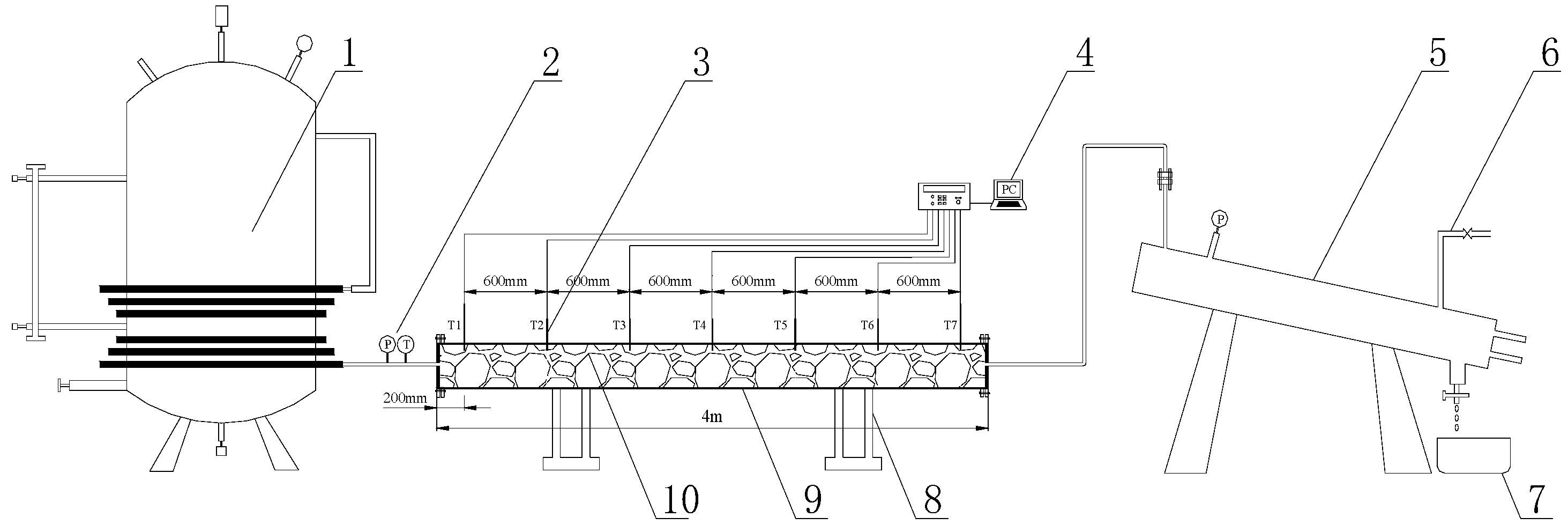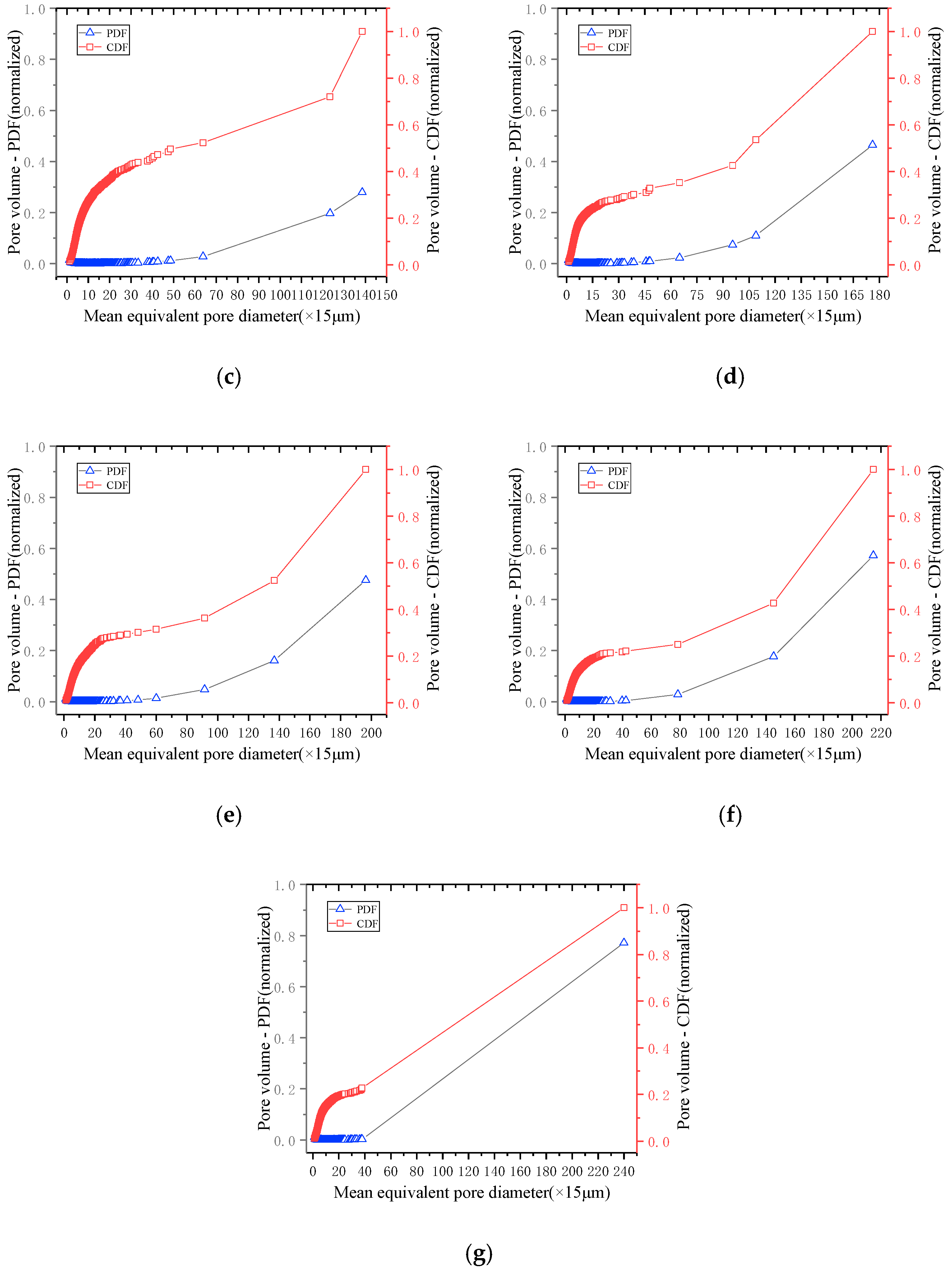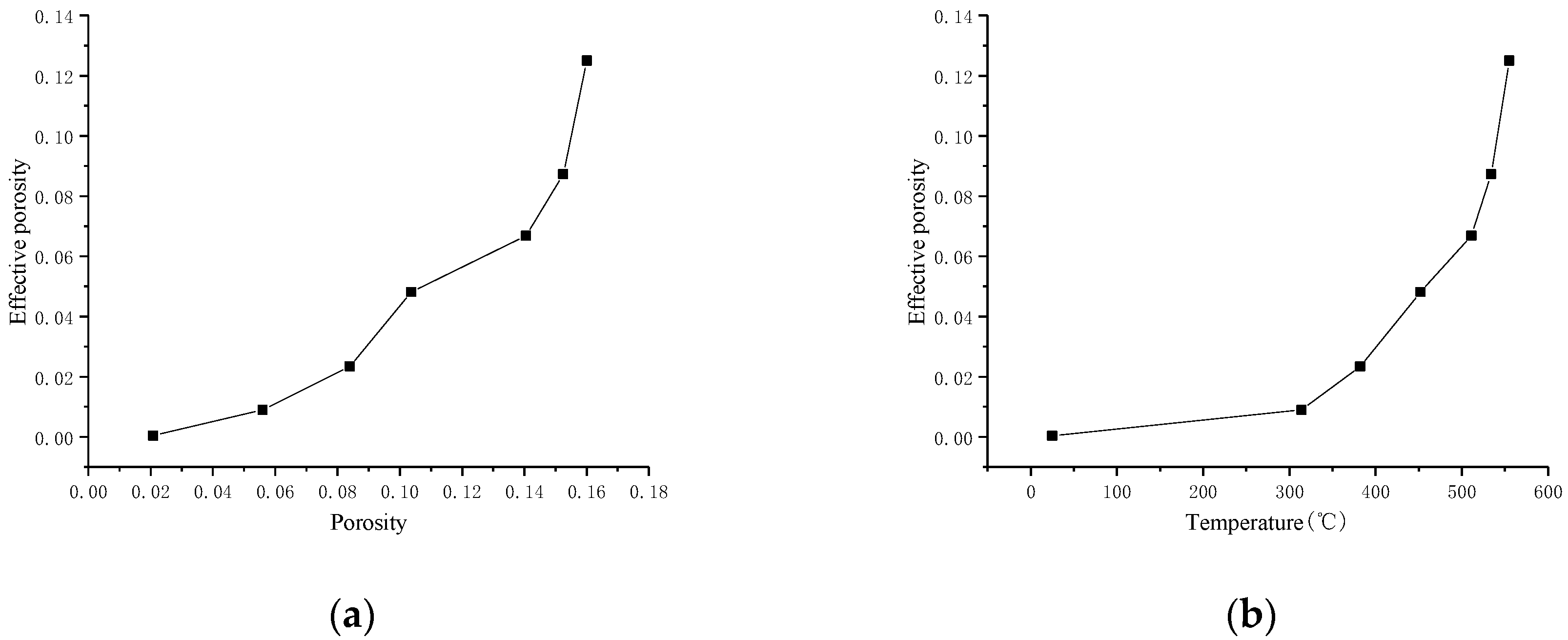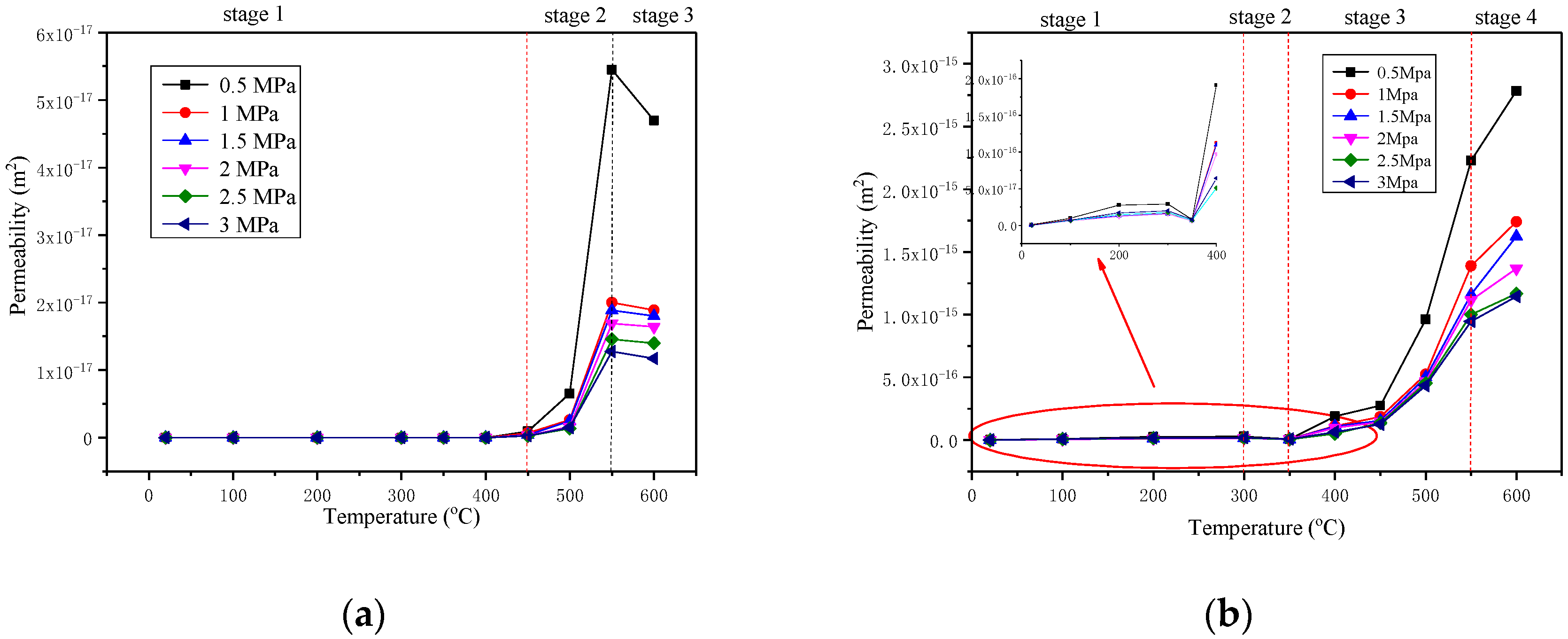Study on the Pore and Fracture Connectivity Characteristics of Oil Shale Pyrolyzed by Superheated Steam
Abstract
1. Introduction
2. Materials and Methods
2.1. Oil Shale Samples
2.2. Superheated Steam Pyrolysis Experimental System and Experimental Procedure
2.3. Superheated Steam Pyrolysis Experimental System and Experimental Procedure
2.4. Re-Scaling Process of the Renormalization Group Method
3. Results and Discussion
3.1. Pore and Fracture Distribution of Oil Shale after Pyrolysis by Superheated Steam at Different Temperatures
3.2. Study on the Evolution of Pore and Fracture Connectivity of Oil Shale after Pyrolysis at Different Superheated Steam Temperatures
3.3. Porosity Variation of Oil Shale CT Slices in Directions Vertical and Parallel to the Sedimentary Bedding and Its Effect on the Permeability
4. Conclusions
Author Contributions
Funding
Acknowledgments
Conflicts of Interest
References
- Solum, M.S.; Mayne, C.L.; Orendt, A.M.; Pugmire, R.J.; Adams, J.; Fletcher, T.H. Characterization of macromolecular structure elements from a green river oil shale, I. Extracts. Energy Fuels 2014, 28, 453–465. [Google Scholar] [CrossRef]
- Jiang, X.M.; Han, X.X.; Cui, Z.G. New technology for the comprehensive utilization of Chinese oil shale resources. Energy 2007. [Google Scholar] [CrossRef]
- Dyni, J.R. Geology and resources of some world oil-shale deposits. Oil Shale 2003, 20, 193–465. [Google Scholar] [CrossRef]
- Wang, L.; Zhao, Y.; Yang, D.; Kang, Z.; Zhao, J. Effect of pyrolysis on oil shale using superheated steam: A case study on the Fushun oil shale, China. Fuel 2019, 253, 1490–1498. [Google Scholar] [CrossRef]
- Sun, Y.; Bai, F.; Liu, B.; Liu, Y.; Guo, M.; Guo, W.; Wang, Q.; Lü, X.; Yang, F.; Yang, Y. Characterization of the oil shale products derived via topochemical reaction method. Fuel 2014. [Google Scholar] [CrossRef]
- Sun, Y.; Kang, S.; Wang, S.; He, L.; Guo, W.; Li, Q.; Deng, S. Subcritical Water Extraction of Huadian Oil Shale at 300 °C. Energy Fuels 2019, 33, 2106–2114. [Google Scholar] [CrossRef]
- Handbook of alternative fuel technologies. Choice Rev. Online 2015. [CrossRef]
- Akob, D.M.; Mumford, A.C.; Orem, W.; Engle, M.A.; Klinges, J.G.; Kent, D.B.; Cozzarelli, I.M. Wastewater Disposal from Unconventional Oil and Gas Development Degrades Stream Quality at a West Virginia Injection Facility. Environ. Sci. Technol. 2016. [Google Scholar] [CrossRef] [PubMed]
- Hammad, M.; Zurigat, Y.; Khzai, S.; Hammad, Z.; Mobydeen, O. Fluidized bed combustion unit for oil shale. Energy Convers. Manag. 1998. [Google Scholar] [CrossRef]
- Soone, J.; Doilov, S. Sustainable utilization of oil shale resources and comparison of contemporary technologies used for oil shale processing. Oil Shale 2003. [Google Scholar] [CrossRef]
- Jaber, J.O.; Probert, S.D. Exploitation of Jordanian Oil-shales. Appl. Energy 1997. [Google Scholar] [CrossRef]
- Ryan, R.C.; Fowler, T.D.; Beer, G.L.; Nair, V. Shell’s in situ conversion process-from laboratory to field pilots. In Oil Shale: A Solution to the Liquid Fuel Dilemma; American Chemical Society: Washington, DC, USA, 2010; pp. 161–183. [Google Scholar]
- Symington, W.A.; Kaminsky, R.D.; Meurer, W.P.; Otten, G.A.; Thomas, M.M.; Yeakel, J.D. ExxonMobil’s ElectrofracTM process for in situ oil shale conversion. In ACS Symposium Series; ACS Publications: Washington, DC, USA, 2010. [Google Scholar]
- Zhao, J.; Yang, D.; Kang, Z.; Feng, Z. A micro-CT study of changes in the internal structure of Daqing and Yan’an oil shales at high temperatures. Oil Shale 2012, 29, 357–367. [Google Scholar] [CrossRef]
- Kang, Z.; Zhao, Y.; Yang, D. Review of oil shale in-situ conversion technology. Appl. Energy 2020, 269, 115121. [Google Scholar] [CrossRef]
- Wang, L.; Yang, D.; Li, X.; Zhao, J.; Wang, G.; Zhao, Y. Macro and meso characteristics of in-situ oil shale pyrolysis using superheated steam. Energies 2018, 11, 2297. [Google Scholar] [CrossRef]
- Saif, T.; Lin, Q.; Gao, Y.; Al-Khulaifi, Y.; Marone, F.; Hollis, D.; Blunt, M.J.; Bijeljic, B. 4D in situ synchrotron X-ray tomographic microscopy and laser-based heating study of oil shale pyrolysis. Appl. Energy 2019, 235, 1468–1475. [Google Scholar] [CrossRef]
- Saif, T.; Lin, Q.; Butcher, A.R.; Bijeljic, B.; Blunt, M.J. Multi-scale multi-dimensional microstructure imaging of oil shale pyrolysis using X-ray micro-tomography, automated ultra-high resolution SEM, MAPS Mineralogy and FIB-SEM. Appl. Energy 2017, 202, 628–647. [Google Scholar] [CrossRef]
- Saif, T.; Lin, Q.; Bijeljic, B.; Blunt, M.J. Microstructural imaging and characterization of oil shale before and after pyrolysis. Fuel 2017, 197, 562–574. [Google Scholar] [CrossRef]
- Saif, T.; Lin, Q.; Singh, K.; Bijeljic, B.; Blunt, M.J. Dynamic imaging of oil shale pyrolysis using synchrotron X-ray microtomography. Geophys. Res. Lett. 2016. [Google Scholar] [CrossRef]
- Zhao, J.; Hu, Q.; Liu, K.; Jin, Z.; Dultz, S.; Kaufmann, J.; Fan, Y. Pore connectivity characterization of shale using integrated wood’s metal impregnation, microscopy, tomography, tracer mapping and porosimetry. Fuel 2020. [Google Scholar] [CrossRef]
- Wu, J.; Yuan, Y.; Niu, S.; Wei, X.; Yang, J. Multiscale characterization of pore structure and connectivity of Wufeng-Longmaxi shale in Sichuan Basin, China. Mar. Pet. Geol. 2020. [Google Scholar] [CrossRef]
- Zhou, X.P.; Zhao, Z. Digital evaluation of nanoscale-pore shale fractal dimension with microstructural insights into shale permeability. J. Nat. Gas Sci. Eng. 2020. [Google Scholar] [CrossRef]
- Tiwari, P.; Deo, M.; Lin, C.L.; Miller, J.D. Characterization of oil shale pore structure before and after pyrolysis by using X-ray micro CT. Fuel 2013, 107, 547–554. [Google Scholar] [CrossRef]
- Tiwari, P.; Deo, M. Compositional and kinetic analysis of oil shale pyrolysis using TGA-MS. Fuel 2012. [Google Scholar] [CrossRef]
- Liu, X.; Lai, J.; Fan, X.; Shu, H.; Wang, G.; Ma, X.; Liu, M.; Guan, M.; Luo, Y. Insights in the pore structure, fluid mobility and oiliness in oil shales of Paleogene Funing Formation in Subei Basin, China. Mar. Pet. Geol. 2020. [Google Scholar] [CrossRef]
- Kang, Z.; Wang, W.; Zhao, Y.; Liang, W.; Yang, D.; Zhao, J.; Zhao, D. Three-dimensional percolation mechanism in oil shale under different temperatures based on micro-CT. Yanshilixue Yu Gongcheng Xuebao/Chinese. J. Rock Mech. Eng. 2014, 33, 1837–1842. [Google Scholar] [CrossRef]
- Stauffer, D.; Aharony, A. Introduction to Percolation Theory; CRC Press: Boca Raton, FL, USA, 2018. [Google Scholar]
- Wilson, K.G. The renormalization group: Critical phenomena and the Kondo problem. Rev. Mod. Phys. 1975, 47, 773. [Google Scholar] [CrossRef]
- Schaap, M.G. Percolation Theory for Flow in Porous Media. Soil Sci. Soc. Am. J. 2006. [Google Scholar] [CrossRef]
- Wang, G.; Yang, D.; Zhao, Y.; Kang, Z.; Zhao, J.; Huang, X. Experimental investigation on anisotropic permeability and its relationship with anisotropic thermal cracking of oil shale under high temperature and triaxial stress. Appl. Therm. Eng. 2019, 146, 718–725. [Google Scholar] [CrossRef]















Publisher’s Note: MDPI stays neutral with regard to jurisdictional claims in published maps and institutional affiliations. |
© 2020 by the authors. Licensee MDPI, Basel, Switzerland. This article is an open access article distributed under the terms and conditions of the Creative Commons Attribution (CC BY) license (http://creativecommons.org/licenses/by/4.0/).
Share and Cite
Huang, X.; Yang, D.; Kang, Z. Study on the Pore and Fracture Connectivity Characteristics of Oil Shale Pyrolyzed by Superheated Steam. Energies 2020, 13, 5716. https://doi.org/10.3390/en13215716
Huang X, Yang D, Kang Z. Study on the Pore and Fracture Connectivity Characteristics of Oil Shale Pyrolyzed by Superheated Steam. Energies. 2020; 13(21):5716. https://doi.org/10.3390/en13215716
Chicago/Turabian StyleHuang, Xudong, Dong Yang, and Zhiqin Kang. 2020. "Study on the Pore and Fracture Connectivity Characteristics of Oil Shale Pyrolyzed by Superheated Steam" Energies 13, no. 21: 5716. https://doi.org/10.3390/en13215716
APA StyleHuang, X., Yang, D., & Kang, Z. (2020). Study on the Pore and Fracture Connectivity Characteristics of Oil Shale Pyrolyzed by Superheated Steam. Energies, 13(21), 5716. https://doi.org/10.3390/en13215716




